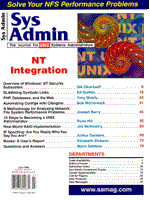
10 Steps to Becoming a UNIX Administrator
Russ Hill Notwithstanding the level of coverage given to Windows NT by the popular press, UNIX systems stand at the core of most mid-sized and large organizations. These systems run everything from mission-critical database applications to dazzling Web sites. The task of keeping these systems humming falls on the shoulders of the UNIX systems administrator. While the job description for a UNIX systems administrator may vary between organizations, the job carries a fair degree of respect within the industry; is often harried, but satisfying; and is reasonably well-paid. Becoming a UNIX systems administrator is thus a career goal worth striving for. Getting there, however, can be a challenge. This article is dedicated to the casual or first-time reader of the magazine who has not yet reached wizard status, but could use a little help on how to get there. UNIX system administration is one of the few master/apprentice jobs still in existence, much like the old apothecary in medieval times. Usually, on-the-job training for a new apprentice is about the only training offered. Most organizations cannot afford to have a sys admin out for a week of vacation, much less for several week-long training sessions. However, times are changing. UNIX administration is now being taught at schools and employers now emphasize academic credentials and certification. The apprenticeship method of training, however, has produced many skilled administrators in the market place. Employers are starting to realize that the background, self-training, and the expected job performance is difficult to maintain for any system administrator. System administration is starting to be considered a career path, and professional salaries are beginning to be more consistent with the level of the skills required. For those who have not yet obtained the wizard's wand of a UNIX system administrator, here are 10 steps toward achieving that goal: 1. Learn UNIX Basics Learn at least 80 basic commands of the UNIX system (for example, cp, and mv). Know the file system structure and where files and directories are located in the hierarchy and why. Learn how to create, modify, and store files using vi and the basics of customizing the UNIX user interface.
2. Go Beyond the Basics Learn more about vi and more of the command set, including df, more, and rm. Learn the ksh and sh environment including .profile and .kshrc. Know the boot up and shutdown procedures as well as the backup and restore procedures, and learn the system administration tools on your system.
3. Learn Shell and Shell-Language Programming Learn how to write shell scripts, Use "for" loops and "if" statements; use awk, sed, ed, cat, and grep commands and learn to pass information to and from shell variables.
4. Become One with Your UNIX System Install and configure a UNIX system from scratch. Make and mount file systems. Use cron to execute program or shell scripts, and configure UNIX for printing. Learn more about UNIX permissions. Learn what each daemon does that is running on your system. Learn Linux.
5. Learn DNS and BIND Learn the Domain Name System (DNS) and Berkeley Internet Name Domain (BIND) and know how to use nslookup, whois, and dig. Read DNS and BIND by Paul Albitz and Cricket Liu. O'Reilly and Associates. ISBN 1565922360 6. Become a Mail Master Configure UNIX to dial out on a modem. Learn about sendmail, mail, and UUCP. Configure UNIX to send email to another system.
7. Learn Networking Learn the TCP/IP layers as well as the OSI model. Learn the applications telnet and ftp, and know what SNMP and SMTP are. Learn about routers and bridges, and how to configure subnet masking. Also read about arp, rarp, bootp, ip, icmp, rip, tcp, udp, bftp, and tftp.
8. Learn the Ns (NFS and NIS) and Outs of UNIX Learn NFS and NIS/NIS+; know how to use hard links and symbolic links. Learn rcp, rlogin, and rsh commands. Revisit shell programming and brush up on using and redirecting the standard-out and standard-error outputs of the UNIX shell.
9. System Tuning and Accounting Learn about UNIX system performance tuning and how to make changes to, and rebuild, the kernel. Learn the accounting packages that come with your UNIX system.
10. C the Light Learn C programming on UNIX; know how to use make. Port programs between UNIX systems.
These books can be found at http://www.amazon.com or http://www.ora.com. About the Author
Russ is a UNIX consultant with Plexnet. He can be reached at: hill2@gte.net.
|